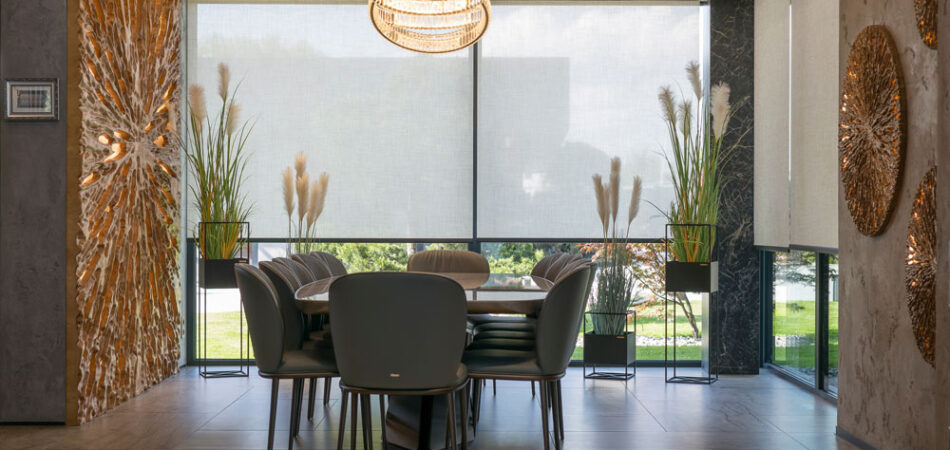
As smart home technology becomes more prevalent, homeowners are increasingly turning to automated solutions for added comfort, efficiency, and style. One standout innovation in this category is motorized blinds. These high-tech window treatments offer a sleek, hands-free approach to light and privacy control, but how exactly do they work? In this blog, we’ll explore the technology behind motorized blinds, their components, power options, and how they integrate with modern smart home systems.
Inside Look: Components of Motorized Blinds
At their core, motorized blinds are similar in function to traditional window coverings but include a few key technological enhancements. These enhancements enable remote control, automation, and integration with smart home platforms.
Motor
The motor is the system’s powerhouse. It’s typically housed within the roller tube or headrail and is responsible for raising, lowering, tilting, or rotating the blinds. Depending on the model, motors can be ultra-quiet or designed for heavy-duty operation.
- Tubular motors are common in roller shades and are placed inside the roller.
- Tilt motors are often used in Venetian blinds to adjust the angle of the slats.
Control Receiver
The receiver is an essential electronic component embedded in the blinds. It receives signals from a remote control, smartphone app, or home automation system. This is the “brain” that interprets user commands and activates the motor accordingly.
Drive Shaft and Gears
These mechanical components transfer the motor’s torque to the blinds, converting electrical energy into movement. The design varies depending on the type of blinds—roller shades, Roman shades, vertical blinds, etc.
Sensors (Optional)
Advanced motorized blind systems may include light or temperature sensors. These sensors automatically adjust the blinds based on environmental conditions, enhancing energy efficiency and user comfort.
Power Options for Motorized Blinds: Battery vs. Wired
Motorized blinds are powered in one of two ways: battery-operated or hardwired. Each option has distinct benefits and considerations.
Battery-Powered Blinds
Battery-operated blinds are popular due to their ease of installation and flexibility. These systems use rechargeable lithium-ion batteries.
Pros:
- Easy installation with no need for an electrician
- Wireless, making them ideal for retrofit projects
- Clean and uncluttered appearance
Cons:
- Requires recharging
- May not be ideal for large or heavy blinds due to power limitations
Battery-powered systems are perfect for residential applications where wall access is limited or aesthetics are a concern.
Hardwired Blinds
Wired motorized blinds are directly connected to your home’s electrical system. This setup is common in new construction or during major renovations.
Pros:
- Continuous power with no need for recharging
- Suitable for large blinds or multiple units connected in a network
- Often includes integration-ready features for smart homes
Cons:
- More complex installation; may require a licensed electrician
- Less flexible if you wish to move or upgrade later
Wired solutions are best for long-term installations, especially in commercial spaces or high-end homes.
Integrating Motorized Blinds into Smart Home Systems
One of the standout features of motorized blinds is their ability to integrate seamlessly into modern smart home systems. This enables automated schedules, voice commands, and even geofencing capabilities.
Compatibility with Smart Hubs
Many motorized blind systems can sync with popular smart hubs like Amazon Alexa, Google Home, and Apple HomeKit. This compatibility allows for:
- Voice control: “Alexa, close the living room blinds.”
- Routine automation: Blinds can close at sunset or open at a specific time each morning.
- Remote access: Control your blinds while you’re away via smartphone apps.
Scene Setting and Automation
By grouping motorized blinds with other smart devices, you can create custom “scenes.” For example, a “Movie Night” scene might close the blinds, dim the lights, and turn on your home theater system—all with a single command.
Geolocation-Based Control
Some advanced systems offer geofencing, which adjusts your blinds based on your location. For example, the blinds can close automatically when you leave home and open when you return.
How Remote Controls & Smartphone Apps Operate Motorized Blinds
Controlling your blinds has never been easier, thanks to modern interfaces. Here’s how the control methods work:
- Remote Control:
Most motorized blinds come with a dedicated remote. With the remote, you can raise, lower, or tilt the blinds at the push of a button. Some remotes even allow you to group blinds in different rooms.
- Smartphone Apps:
Manufacturers often offer apps that let you control your blinds remotely. These apps can:
- Set schedules
- Group multiple blinds by room
- Adjust settings even when you’re not home
- Voice Assistants:
With the appropriate hub, voice assistants can control blinds via spoken commands. It adds hands-free convenience, especially helpful for large homes or people with mobility challenges.
Installation Tips for Motorized Blind Systems
Proper installation ensures long-term performance and safety. Here are key tips to consider:
- Measure Accurately:
Whether you’re installing inside or outside the window frame, precise measurements are crucial for smooth operation and a clean look.
- Assess Power Needs:
You can choose between battery and wired systems based on your home layout, the number of blinds, and access to outlets or wiring channels.
- Professional Installation Recommended:
While some DIY-friendly kits exist, professional installation is often the better choice, especially for hardwired systems or complex integrations.
- Plan for Integration:
If you’re using smart home platforms, ensure your blinds are compatible with your existing devices or hub.
- Maintain Regularly:
Check batteries (if applicable), clean the blinds, and occasionally test the motor to catch any issues early.
Cost Overview: Motorized Blinds vs. Manual Blinds
Cost is a key factor for many homeowners weighing the decision between manual and motorized blinds.
Although motorized blinds have a higher upfront cost, they often pay off through convenience, energy savings, and added property value.
Why Choose Colby Window Solutions for Your Motorized Blinds?
Since 2009, Colby Window Solutions has been a trusted name in Arizona for high-quality window coverings. As a locally owned and operated company, we specialize in both interior and exterior products that align with contemporary design trends.
Our Offerings Include:
- Smart and motorized blinds
- Sun shades for windows
- Custom shutters, roller shades, and window films
- Solutions that enhance both aesthetics and energy efficiency
We are proud to be a recognized contractor for SRP Rebates, helping you save even more when upgrading your home’s window treatments.
Why Partner with Us?
- Expertise: Over 15 years of experience in the field
- Customization: Tailored solutions to meet your design and automation needs
- Quality: We work with top brands and stand behind our installations
- Service: Free in-home estimates and consultations
Transform Your Home Today
Ready to experience the ease and elegance of motorized blinds in your home or office? Whether you’re retrofitting existing windows or planning a new build, Colby Window Solutions has the expertise and range of products to bring your vision to life.
Contact us today for a consultation and free estimate.
